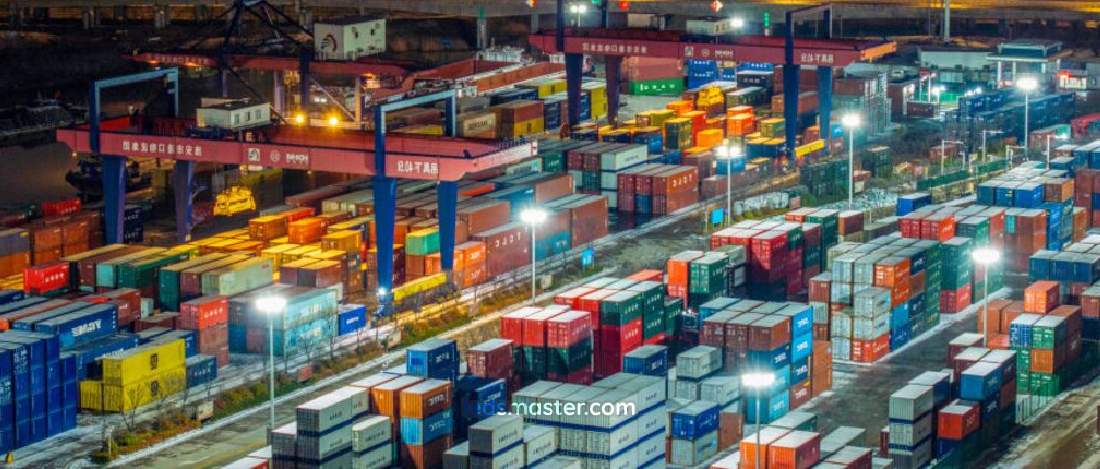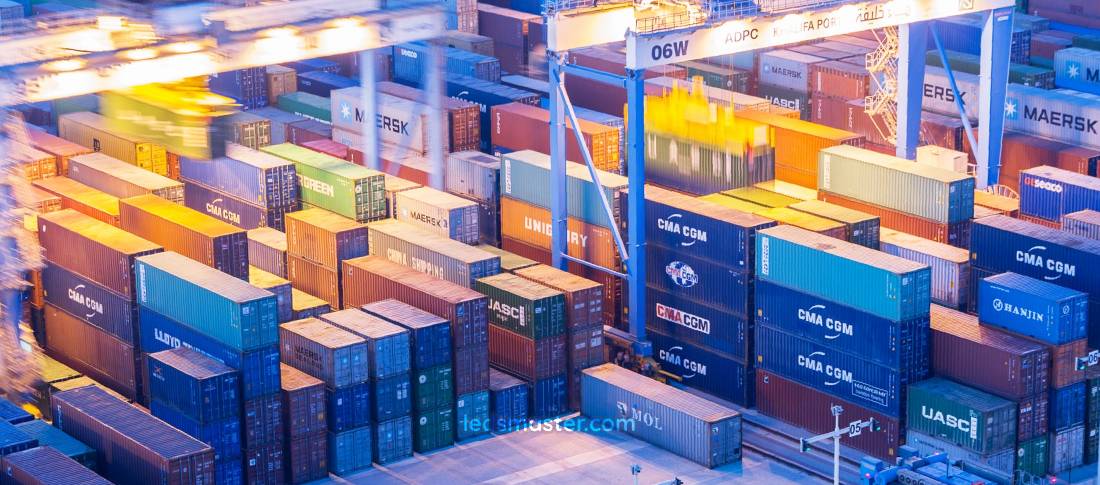Container port lighting is designed to endure harsh maritime conditions, featuring corrosion-resistant materials and robust construction for reliability. Utilizing advanced LED technology, these systems enhance operational safety and efficiency while minimizing environmental impact through energy-efficient solutions.
Container ports are hubs in global trade, facilitating the movement of goods between ships and land-based transportation networks. Efficient lighting systems are essential in these environments to ensure safe operations, especially during night shifts and adverse weather conditions. This article explores the key considerations and technologies involved in container port lighting, focusing on sea water resistance, durability, wind resistance, and other critical factors.
Get your complimentary lighting design today
Table of Contents
ToggleOne of the foremost challenges in container port lighting is the corrosive nature of sea water. Ports are exposed to salt spray, humidity, and occasional immersion during storms or high tides. Lighting fixtures must withstand these harsh conditions to maintain functionality and longevity.
LED lighting has emerged as a preferred choice due to its robustness and resistance to corrosion. Enclosures and seals designed specifically for maritime environments help prevent water ingress, ensuring that internal components remain protected from salt and moisture. Advanced materials such as marine-grade stainless steel and durable polymers further enhance resilience against corrosion, prolonging the operational life of port lighting systems.

Durability in lighting fixtures is not merely a matter of longevity; maintain the overall functionality of the port. With heavy equipment constantly moving and operating in close proximity to lighting installations, fixtures are exposed to significant mechanical shocks. These shocks can result from the movement of cargo, the transportation of containers, and the handling of various materials. Each of these activities generates vibrations and impacts that can lead to premature failure if the lighting systems are not sufficiently robust.
Modern lighting solutions specifically designed for container ports typically feature rugged construction. These fixtures often incorporate reinforced housings made from durable materials such as aluminum or high-strength polycarbonate. These materials provide protection against the wear and tear that is commonplace in a port environment. Additionally, many fixtures utilize impact-resistant lenses, which are designed to withstand potential collisions from handling equipment or accidental bumps. This combination of materials and construction methods is essential for minimizing downtime and reducing maintenance costs, thereby ensuring that port operations can continue smoothly without interruptions.
Manufacturers often use weatherproof seals and coatings to protect against corrosion caused by exposure to saltwater and humidity. These features enhance the longevity of the lighting systems, allowing them to operate effectively in harsh marine environments. Such durability not only reduces the need for frequent replacements but also contributes to the overall sustainability of port operations by minimizing waste.
The stability of lighting fixtures is further enhanced by robust mounting systems designed to withstand the challenges posed by turbulent weather conditions. Given that many container ports are situated in coastal regions, they are regularly exposed to strong winds and inclement weather. These environmental factors can have a detrimental effect on the performance of lighting installations. Therefore, effective mounting solutions are paramount.
Ports frequently face strong winds that can impact the stability and performance of lighting installations. Therefore, the design of lighting fixtures must incorporate wind resistance considerations to prevent fixture displacement or damage, ensuring continuous operation even during adverse weather conditions. The design process is centered around creating fixtures that can withstand the challenges posed by coastal winds, contributing to the overall safety and efficiency of port operations.
One of the primary strategies employed by lighting engineers to enhance wind resistance is the incorporation of aerodynamic principles into the design of fixtures. By optimizing the shape of the fixtures, engineers can reduce the wind load on the lighting systems. This design strategy minimizes the potential for fixture displacement and improves the overall aesthetic appeal of the installations.
Fixed and adjustable mounting brackets are specifically engineered to withstand gusts typical of coastal regions. These brackets are tested under various wind load conditions to ensure their reliability in real-world scenarios. The use of high-quality materials further enhances their durability, allowing them to maintain optimal positioning and alignment for effective lighting coverage.
Furthermore, the placement of fixtures enhance wind stability. Engineers conduct comprehensive assessments of the port layout, identifying locations where lighting can be installed to minimize exposure to strong winds. By considering the interactions between wind patterns and the port’s physical infrastructure, they can develop lighting strategies that enhance stability and reliability.
In addition to the challenges posed by wind and weather, container port lighting systems must comply with stringent environmental regulations and safety standards. This is particularly relevant given the unique challenges presented by the marine environment, which includes exposure to saltwater and other corrosive elements. Lighting systems are designed with materials and coatings that can resist these environmental stresses, ensuring longevity and reliability.
The choice of lighting technology impacts compliance with environmental regulations. LED technology has emerged as a favored option for port lighting due to its energy efficiency and minimal impact on the environment. LED fixtures consume significantly less energy than traditional lighting technologies, leading to reduced carbon emissions and lower operational costs. By minimizing energy consumption, ports can align with sustainability initiatives while ensuring their lighting systems remain compliant with regulatory requirements.
The environmental benefits of LED technology extend beyond energy efficiency. LED fixtures typically have longer lifespans, which reduces the frequency of replacements. This longevity contributes to a decrease in waste, further supporting sustainability goals. Additionally, the use of LEDs helps minimize light pollution, a growing concern in coastal ecosystems. By emitting focused light with minimal spillage, LED fixtures allow ports to operate efficiently without adversely affecting surrounding wildlife and habitats.
Integrated lighting controls enhance environmental adaptability by allowing ports to optimize energy consumption based on operational needs. These controls enable the adjustment of lighting levels in response to real-time conditions, ensuring that energy is used efficiently. Features such as motion sensors, daylight harvesting, and programmable dimming further contribute to the sustainability of port lighting systems.
Motion sensors detect the presence of personnel and vehicles, allowing lights to operate at full brightness only when needed. During low-traffic periods, the system can automatically dim or turn off lights, reducing unnecessary energy consumption. Daylight harvesting utilizes natural light to minimize reliance on artificial illumination, further enhancing energy efficiency.
The programmability of modern lighting controls allows ports to tailor lighting schedules based on specific operational requirements. For instance, lights can be set to dim during late-night hours when activity is minimal, ensuring that energy is conserved without compromising safety. This level of adaptability aligns with eco-friendly practices and helps ports meet regulatory requirements related to energy use and environmental impact.
Recent advancements in lighting technology continue to transform container port operations, offering improved visibility and operational efficiency. Smart lighting solutions equipped with IoT connectivity enable real-time monitoring and remote management of luminaires. This connectivity allows port operators to proactively manage their lighting systems, optimizing performance and reducing maintenance costs.
The integration of smart technology into lighting systems facilitates proactive maintenance. By leveraging IoT connectivity, ports can monitor the performance of their lighting fixtures in real time. This capability allows operators to identify potential issues before they become significant problems, minimizing downtime and maintenance costs.
Remote management of luminaires also enables ports to optimize energy consumption effectively. Operators can adjust lighting levels and schedules from a centralized system, ensuring that lights are operating efficiently based on real-time conditions. This level of control enhances overall operational efficiency and aligns with sustainability initiatives.
Lighting simulations and photometric studies are tools used in optimizing lighting layouts within container ports. By analyzing light distribution patterns and lux levels across various terminal areas, engineers can achieve uniform illumination while minimizing glare and light spillage. This precision in lighting design is vital for enhancing safety for personnel and improving visibility during loading and unloading operations.

In the complex environment of a container port, robust lighting solutions ensure ensuring clear visibility for navigational aids, berths, and transit routes. Maintaining optimal lighting levels while minimizing glare is vital for facilitating safe vessel maneuverability, both during the day and at night. This clarity in visibility reduces the likelihood of collisions and operational delays, supporting the overall functionality of port activities.
Effective lighting solutions enhance the navigational experience for vessels approaching or departing from the port. Clear and well-lit navigation markers help vessels identify their positions and safely navigate through busy shipping lanes. By providing reliable illumination for berths and transit routes, ports enable vessels to maneuver with confidence, ensuring that they can operate safely.
Additionally, well-lit loading and unloading areas improve safety for personnel working in close proximity to moving equipment. Adequate lighting allows workers to see their surroundings clearly, reducing the risk of accidents. Furthermore, minimizing glare from lighting fixtures contributes to improved visibility for both personnel and vessel operators, further enhancing safety.
When visibility is optimized, personnel can work more effectively, leading to faster turnaround times for loading and unloading operations. This efficiency not only benefits the port but also supports the broader supply chain by ensuring that goods are moved quickly and safely.
Efficient lighting designs optimize port logistics by enabling uninterrupted cargo handling and vessel operations. Advanced LED technologies offer superior energy efficiency and longevity, reducing maintenance costs while supporting sustainable practices in port management.
Container port lighting systems are indispensable for ensuring safety, efficiency, and environmental compliance in maritime operations. Designed to withstand the corrosive effects of sea water, the rigorous demands of high-traffic environments, and the challenges posed by strong winds, these lighting solutions embody resilience and reliability. Advanced technologies such as LED fixtures not only enhance visibility and operational efficiency but also contribute to sustainable port management practices. By continually innovating and integrating smart lighting solutions, ports can further optimize their logistics operations, reduce energy consumption, and uphold safety standards, thereby supporting seamless global trade and maritime logistics into the future.